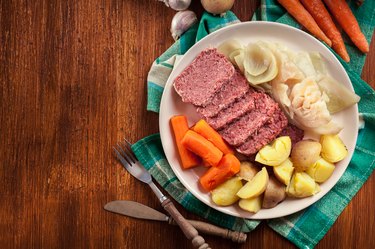After Cooking Corned Beef Do You Store It in the Broth

Corned beef and cabbage can be prepared in the oven, in a slow cooker or on the stovetop.
Image Credit: fotek/iStock/GettyImages
Cooking and reheating corned beef and cabbage doesn't require too many steps. With a little prep, you can make this delicious, hearty meal and enjoy it for days to come (not just on St. Patrick's Day).
Plus, there are ways to cut down the cooking time without sacrificing flavor.
Tip
Corned beef and cabbage can be prepared in the oven, in a slow cooker or on the stovetop, depending on your preferences. You can cook it ahead of time and reheat it in the oven until the meat reaches an internal temperature of 165 degrees Fahrenheit or higher.
How to Cook Corned Beef and Cabbage
You can make ahead the corn beef brisket and cook it along with cabbage and other veggies, like our Roasted Beets recipe, whenever you have guests. This tough cut of meat is often sold already cooked in grocery stores, making it ideal for those who are short on time.
According to Ohio State University, corned beef is brined or cured using a mixture of salt water or sodium nitrite, which is why it's pink. In general, it consists of brisket. Most recipes that require this ingredient, such as corned beef hash, are associated with Irish cuisine.
Tip
To save time, buy pre-brined corned beef from your local grocery store. Ideally, choose an organic version to avoid food additives, artificial flavors and other harsh chemicals. Cooked corned beef is flavorful and tender, so it takes little time to prepare.
Cut the carrots, potatoes, onions and other veggies into chunks on a cutting board. Cut the cabbage into quarters. Depending on the recipe, you may also add garlic, celery, herbs and spices. Some chefs also add sugar, but it's not really necessary.
In a Slow Cooker
If you wish to use a slow cooker, follow these steps:
- Add the vegetables and then the corned beef to a slow cooker.
- Pour water or broth into the slow cooker just to cover the meat.
- Cover and cook on high for one hour. Switch to the low setting and cook for another 10 to 12 hours. If you're in a rush, you may cook on the high setting for five to six hours, as recommended by the Ohio State University.
- Add the cabbage in the last three hours of cooking. Your meal is ready when the beef and cabbage are tender.
On the Stove
Another option is to use the stovetop for this recipe. Here's what you need to do:
- Place the corned beef fat-side up in a large stockpot. Add salt, herbs and spices, or the spice mixture that came with it.
- Add water, beer or broth until the beef is covered completely.
- Bring to a boil, cover and then simmer over low heat (about one hour per pound of meat).
- Add the cabbage and other vegetables in the last 20 to 30 minutes of cooking, advises the Ohio State University.
In the Oven
If you prefer to make baked corned beef and cabbage, here's what you'll need to do: a
-
Add all ingredients to a large roasting pan. Place the meat fat side-up.
-
Preheat the oven at 350 F
and sprinkle your favorite spices over it.
-
Add some water, about a 1/2 cup or just enough to slightly cover the beef.
-
Cook until the meat and cabbage are tender. If you're using raw corned beef, cook it until its internal temperature reaches at least 145 F to ensure that all bacteria have been destroyed, per the USDA Food Safety and Inspection Service (USDA FSIS).
How to Reheat Corned Beef and Cabbage
Corned beef can be refrigerated for up to four days or stored in the freezer for up to three months, according to the USDA FSIS. Cooked meat dishes, including leftovers, can be kept in the freezer for two to six months or refrigerated for three or four days, per the U.S. Department of Health & Human Services.
Here's how to reheat corned beef and cabbage in the oven:
- Fill a medium pan with just enough of the dish for your next meal.
- Reheat it in the oven until the meat reaches a minimum internal temperature of 165 F, as recommended by the USDA FSIS.
Warning
If the beef has a strange odor or its color has changed, throw it out.
Remember to watch your portions. Corned beef, whether you prepare it at home or buy it pre-cooked, is high in sodium, points out the University of Florida Health. For example, a 2-ounce serving of corned beef from Nestle boasts 550 milligrams of sodium, or 24 percent of the daily recommended intake. Plus, pre-cooked varieties often contain added sugar.
Eating too much salt can skyrocket your blood pressure and put you at risk for stroke, kidney disease, heart failure and osteoporosis, per the American Heart Association. On top of that, it may cause bloating and fluid retention. To stay safe, try not to exceed 2,300 milligrams of sodium per day.
Source: https://www.livestrong.com/article/434985-how-to-cook-corned-beef-cabbage-the-night-before-reheat-it-in-the-oven/
0 Response to "After Cooking Corned Beef Do You Store It in the Broth"
Post a Comment